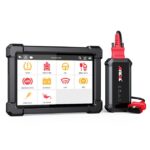Modern vehicles are complex machines, relying heavily on electronic control units (ECUs) and sensors to operate efficiently and safely. When components are replaced or repairs are made, sometimes these systems need to be “relearned” or recalibrated to function correctly with the new or adjusted parts. This is where the “relearn” function of an OBD scanner becomes invaluable.
What Does “Relearn” Mean in Automotive Diagnostics?
In the context of car repair, “relearn” refers to the process of teaching or re-introducing a vehicle’s computer to a component that has been replaced or adjusted. Think of it as a system reset or recalibration. Many systems in your car, from the tire pressure monitoring system (TPMS) to the engine’s idle control, require this relearn process after certain maintenance procedures. Without it, you might experience warning lights, poor performance, or even system malfunctions.
Why is an OBD Scanner Relearn Function Important?
OBD (On-Board Diagnostics) scanners are tools that communicate with your car’s computer. Advanced scanners offer a “relearn” function because many modern vehicle repairs and maintenance tasks necessitate this procedure. Here are a few key reasons why this feature is crucial:
-
TPMS Relearn: When you rotate or replace your tires, especially if they have TPMS sensors, the system needs to relearn the position of each sensor. An OBD scanner with relearn capabilities can quickly initiate this process, turning off the TPMS warning light.
-
Throttle Body Relearn: After cleaning or replacing the throttle body, the ECU needs to relearn the idle air control and throttle position. This ensures smooth idling and proper engine performance.
-
Steering Angle Sensor Relearn: If you’ve had your steering or suspension worked on, the steering angle sensor might need to be recalibrated. This is important for systems like electronic stability control (ESC) and lane departure warning to function correctly.
-
Idle Relearn: Similar to throttle body relearn, an idle relearn may be required after battery disconnection or ECU resets to ensure the engine idles smoothly at the correct RPM.
Limitations of OBD Scanner Relearn Functions
While OBD scanners with relearn functions are powerful tools, it’s important to understand their limitations:
-
AutoAuth for FCA Vehicles: For newer Fiat Chrysler Automobiles (FCA) vehicles (2018 and newer), some advanced functions, including certain relearn procedures, may require AutoAuth access. Basic OBD2 scanners may have limited access to these functions. For comprehensive access on FCA vehicles, specialized tools like the Innova 7111 tablet, which supports AutoAuth, might be necessary.
-
Reprogramming and Key Fob Programming: Standard OBD scanners, even with relearn functions, are not designed for ECU reprogramming or key fob programming. These are separate, more complex procedures that often require specialized equipment.
Choosing the Right OBD Scanner with Relearn Capability
When selecting an OBD scanner, especially if you anticipate performing relearn procedures, consider the following:
- Relearn Functions Supported: Check the scanner’s specifications to ensure it supports the specific relearn functions you need, such as TPMS relearn, throttle relearn, etc.
- Vehicle Coverage: Verify that the scanner is compatible with your vehicle’s make, model, and year. Use a coverage checker tool if available.
- Ease of Use: Look for a scanner with a user-friendly interface and clear instructions for performing relearn procedures.
In conclusion, the “relearn” function in OBD scanners is an essential capability for diagnosing and resolving issues in modern vehicles. Understanding when and why relearn is needed, and choosing the right scanner for the job, can empower both DIYers and professional mechanics to perform effective and accurate automotive repairs.


